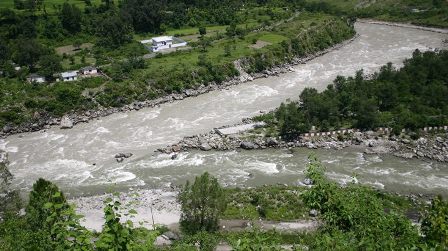Human Greed Costs: 75 per cent Himalayan Springs drying up
Deforestation releases carbon stored in trees, but it also disrupts the world’s hydrological cycle. States such as Uttarakhand have to show the way, to implement a scheme on ‘Pahad Paani Parampara’ to rejuvenate its traditional techniques of natural water resources springs, dhare, naule, gul, gadhere aquifer.

In the past few decades, climate change has been blamed for extreme weather events like erratic rainfall, super cyclones, and flooding and rise in sea levels. Nature, water and weather – the delicate balance between evaporation and precipitation – is the primary cycle through which climate change is felt.
In 2017, carbon dioxide concentration reached a global average of 405 parts per million, which was the highest ever recorded. As the earth’s average temperature continues to rise, we can expect a significant impact on water resources with the potential for devastating effects on these resources.
Notably, only three per cent of the planet’s water is fresh water, and of this, two-thirds is captured in glaciers and polar ice.
The global warming caused by fossil fuel use has likely exacerbated the economic inequality associated with historical disparities in energy consumption. Water shortage is becoming commonplace worldwide and deforestation is making the problem worse.
“There is an intricate link between forests, water, people and the climate. Ensuring there is continued flow of green water — there is water moving through trees, plants and soils — is the only way to maintain a healthy global water system. Deforestation releases carbon stored in trees, but it also disrupts the world’s hydrological cycle.”
The changes in rain and wind due to deforestation provide tangible evidence of the link between deforestation and climate change.
Why springs matter?
With climate change manifested in the form of rising temperatures, rise in rainfall intensity, reduction in its temporal spread and a marked decline in winter rain, the problem of dying springs is being increasingly felt across the region.
Water losses due to increasing temperatures, changing rainfall, snowfall and snow melting patterns, results in erosion and landslide patterns when rainfall comes in more frequent sudden spurts.
Also Read : Clouded Consciousness: World’s responses to IPCC Report
There is also the factor of increasing demand both for evaporation-transpiration and human and other living forms needs. Noted environmentalist and archaeologist Padma Shri Prof. Dr. Yashodhar Mathpal said clearly, something needs to be in action about the policy of spring shed management, as is evident in the case of central Himalayan region districts, which have not yielded commensurate benefits. States such as Uttarakhand have to show the way, to implement a scheme on ‘Pahad Paani Parampara’ to rejuvenate its traditional techniques of natural water resources springs such as dhare, naule, gul and gadhere aquifer.
According to environment activist Manohar Singh Manral, the rainfall will be lesser than snowfall which would in turn reduce the snowfall. In the past years, nearly three hundred small rivers of Uttarakhand have remained barren and haven’t had seasonal rainfall.

Like the Roorkee Salani, Rispana of Dehradun, Bindal, Kankadjala of Nainital, Himalayas of Pauri, Chandraghaga of Rishikesh, etc. The waters of famous river Malini Ramganga, Balakhila, Kamalganga, Kosi and Nayar are reducing in volume. Their length is also decreasing; In the past years, due to their decline, there is a decrease of 30 percent in the water of Ganga.
When it comes to the 16,000 plus Himalayan glaciers, rivers are said to be dependent on Ganga, Indus and Brahmaputra. When these mighty rivers are themselves fighting for survival, what happens to the smaller springs? Most Himalayan states have taken the initiative of constructing hundreds of hydro-electric projects but what is the point when the livelihood of the locals hangs in balance?
“The second crisis is that there are innumerable small rivers and gadheras that feed the big rivers, whose water reservoirs are continuously decreasing.”
According to Dr. Naveen Chandra Joshi ecologist in Wild Life Institute of India, Dehradun, “The broad leaf forests are slowly gaining ground, bypassing the traditional rights of the forest dwellers and conservation and promotion of natural resources. What will happen by imposing imported plans and projects on the Himalayas?”
In the Himalayan regions, there is ample diversity in the level of availability. Today, the tap water culture of the water corporation has finished the traditional water practices. Slowly, people started going near the naval docks. Due to lack of access to the navy, people also stopped the maintenance of these naula water temple.
Also Read : Water Crisis in Himalayan Ecosystems: The Way Forward
According to Dr. Girish Negi of GBPIHED, Almora, in the race of human development, the people started forgetting that excessive exploitation of ground water, chemical cultivation and the use of harmful components in the work hamper their own livelihood.
Due to the use of chemical fertilizers in irrigated farming, soil health is damaged. The rigidity increased. Due to the use of pesticides, the quality of soil, air and water has become polluted.
The same groundwater is now available in wells and tube wells.
According to a UN study; limiting global warming to 1.5ºC would require rapid, far-reaching and unprecedented changes in all aspects of society, the Intergovernmental Panel on Climate Change (IPCC) said in an assessment. With clear benefits to people and natural ecosystems, limiting global warming to 1.5ºC compared to 2ºC could go hand in hand with ensuring a more sustainable and equitable society. A recent study on Water and Climate Change will not only result in disasters, but has to study its effect on water quality, biodiversity, and other ecological processes.
